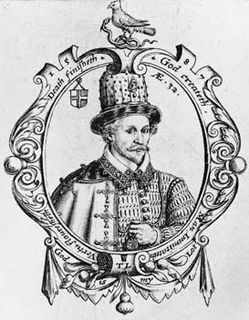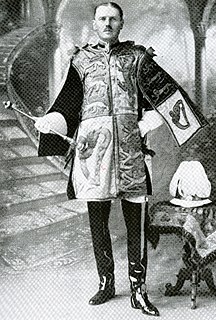This article needs additional citations for verification .(December 2009) (Learn how and when to remove this template message) |

The Heralds' Museum was a museum of heraldry run by the College of Arms Trust at the Tower of London during the 1980s. It was situated in the old Waterloo Barracks within the Tower.

Heraldry is a broad term, encompassing the design, display, and study of armorial bearings, as well as related disciplines, such as vexillology, together with the study of ceremony, rank, and pedigree. Armory, the best-known branch of heraldry, concerns the design and transmission of the heraldic achievement. The achievement, or armorial bearings usually includes a coat of arms on an shield, helmet, and crest, together with any accompanying devices, such as supporters, badges, heraldic banners, and mottoes.

The Tower of London, officially Her Majesty's Royal Palace and Fortress of the Tower of London, is a historic castle located on the north bank of the River Thames in central London. It lies within the London Borough of Tower Hamlets, separated from the eastern edge of the square mile of the City of London by the open space known as Tower Hill. It was founded towards the end of 1066 as part of the Norman Conquest of England. The White Tower, which gives the entire castle its name, was built by William the Conqueror in 1078 and was a resented symbol of oppression, inflicted upon London by the new ruling elite. The castle was used as a prison from 1100 until 1952, although that was not its primary purpose. A grand palace early in its history, it served as a royal residence. As a whole, the Tower is a complex of several buildings set within two concentric rings of defensive walls and a moat. There were several phases of expansion, mainly under Kings Richard I, Henry III, and Edward I in the 12th and 13th centuries. The general layout established by the late 13th century remains despite later activity on the site.
The original idea came from Sir Anthony Wagner, Garter Principal King of Arms. Wagner hoped to establish a museum in which to display the treasures of the College of Arms itself. A plan for a building adjacent to the college was commissioned from Raymond Erith, but not taken forward due to the increasing financial demands of repairs to the college building. [1]

Sir Anthony Richard Wagner was a long-serving Officer of Arms at the College of Arms in London. He served as Garter Principal King of Arms before retiring to the post of Clarenceux King of Arms. He was one of the most prolific authors on the subjects of heraldry and genealogy of the 20th century.

The Garter Principal King of Arms is the senior King of Arms, and the senior Officer of Arms of the College of Arms, the heraldic authority with jurisdiction over England, Wales and Northern Ireland. The position has existed since 1415.

A museum is an institution that cares for (conserves) a collection of artifacts and other objects of artistic, cultural, historical, or scientific importance. Many public museums make these items available for public viewing through exhibits that may be permanent or temporary. The largest museums are located in major cities throughout the world, while thousands of local museums exist in smaller cities, towns and rural areas. Museums have varying aims, ranging from serving researchers and specialists to serving the general public. The goal of serving researchers is increasingly shifting to serving the general public.
In 1980 the Heralds' Museum was opened by the Duke of Kent [2] as part of the Tower of London. The museum was open during the summer season and admission was included in admission to the Tower. Exhibits included items from the collection of College of Arms and artifacts borrowed from other sources. [1] Peter Spurrier served as its curator, [3] and John Brooke-Little as its director. [4]

The title of Duke of Kent has been created several times in the peerages of Great Britain and the United Kingdom, most recently as a royal dukedom for the fourth son of King George V. Since 1942, the title has been held by Prince Edward, Queen Elizabeth II's cousin.
Peter Brotherton Spurrier was an officer of arms at the College of Arms in London. He was appointed Portcullis Pursuivant of Arms in Ordinary in 1981 and York Herald of Arms in Ordinary in 1992. He retired from the College of Arms in May 1993.

John Philip Brook Brooke-Little, was an influential and popular English writer on heraldic subjects, and a long-serving herald at the College of Arms in London. In 1947, while still a student, Brooke-Little founded the Society of Heraldic Antiquaries, now known as the Heraldry Society and recognised as one of the leading learned societies in its field. He served as the society's chairman for 50 years and then as its President from 1997 until his death in 2006. In addition to the foundation of this group, Brooke-Little was involved in other heraldic groups and societies and worked for many years as an officer of arms; beginning as Bluemantle Pursuivant, Brooke-Little rose to the second highest heraldic office in England: Clarenceux King of Arms.
The museum closed later in the 1980s following the reorganisation of the Royal Palaces. [4]














